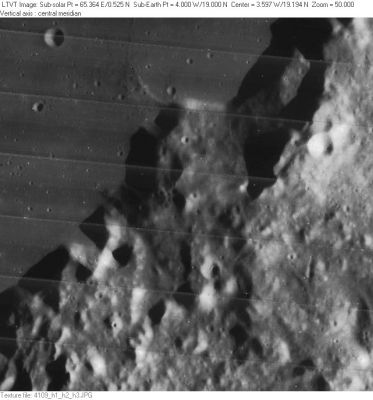Mons Ampère
Contents
Mons Ampère
|
Lat: 19.32°N, Long: 3.71°W, Diam: 29.96 km, Height: 3 km, Rükl: 22 |
LO-IV-109H Mons Ampère is in the center; with the spine of Mons Huygens running through the upper right part of the frame. The small circular crater in the extreme upper left is Huxley.
Images
LPOD Photo Gallery Lunar Orbiter Images
- Mons Ampere was also captured by the Metric/ Mapping Fairchild camera of Apollo 17. AS17-M-2432 shows Mons Ampere near the centre of the frame.
- Research orbital Apollo 17 photography: Danny Caes
Maps
(LAC zone 41D3) LAC map Geologic map LM map
Description
Wikipedia
Additional Information
- IAU page: Mons Ampère
- Depth data from Kurt Fisher database
- Viscardy, 1985: 3 km
- Height was measured as 4.2km plus or minus 200m (Boint 2001. Thesis. Augustana College, Sioux Falls, SD).- fatastronomer fatastronomer
The two bright starlike dots at Mons Ampere (a curious clair-obscur effect)
- A curious clair-obscur effect, noticed by Danny Caes, can be seen when the morning-terminator runs at 9 degrees west (over Mons Pico). The first rays of sunlight (which catch the highest points on Mons Ampère) create the appearance of two bright "stars" or "dots" in (what seems to be, or looks like) a pitch black valley to the south of Mons Huygens. This effect can be seen in a photo by Israel Ramirez in the LPOD Gallery, as well as in one by dedicated lunar observer Stefan Lammel. It can also be seen in Plate C9 of the Consolidated Lunar Atlas. In Plate C10 the peaks are more strongly illuminated, in Plate C13 Mons Ampère has come fully into sunlight. See also LPOD A New Look
- The peaks responsible for Danny's dots are the small one midway down the spine of Mons Ampère at 19.2°N/3.6°W (the one with a little 1-km crater on its northeast flank -- apparently made visible by virtue of a low spot in Mons Huygens to its east), and the larger one at 18.6°N/3.5°W (at the tip of the shadowed north-south spine, with a 4-km depressen to its northeast). When this effect is visible, the headland to the south of Mons Ampère has a shape that mimics that of Mons Ampère seen with a higher sun. This gives the impression that the dots are located between Mons Huygens and Mons Ampère, although they are actually the crest of Mons Ampère itself. - Jim Mosher
- This curious clair-obscur effect was also captured during the mission of Apollo 17. Three of Apollo 17's oblique southward looking Metric/ Mapping Fairchild camera photographs show the two starlike dots near the right margins of the frames. These frames are AS17-M-1677, 1678, and 1679. Vertical Fairchild frame AS17-M-1827 also shows the same two starlike dots, although in this frame the sun's altitude was a little bit more than in the three oblique southward looking frames. In this vertical frame, several small minute specks are seen near the two major dots. - DannyCaes Jul 26, 2014
Nomenclature
- Named for André-Marie Ampère (1775-1836), a French physicist.
- This name was introduced by Julius Schmidt (Whitaker, p. 224). The name was apparently Latinized to Mons Ampère in the early 1960's (see the 1961 nomenclature directives in IAU Transactions XIB), although it was labeled simply Ampère (without "Mount" or "Mons) on both LAC-41 the Quad Maps of the System of Lunar Craters.
LPOD Articles
Bibliography
Named Features -- Prev: Sinus Amoris -- Next: Amundsen
